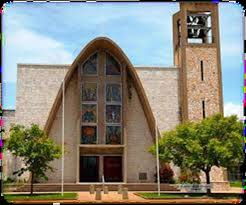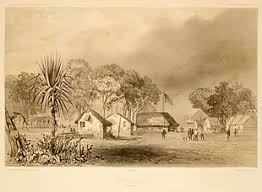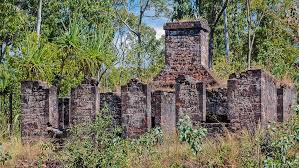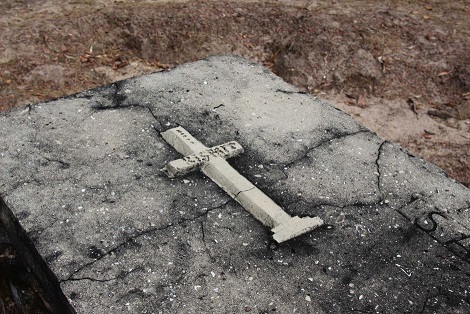Darwin ceremony: Bishop Charles Gauci and the Confalonieri Plaque
Fr Malcolm Fyfe, Vicar General of the Diocese of Darwin has sent the following news.

On the First Sunday of Advent, November 29th at the 9.30 am Mass in St Mary’s Cathedral, Bishop Charles blessed a plaque commemorating Father Angelo Confalonieri and affix it to the wall inside the Cathedral.
Father Angelo Confalonieri, 1813-1848, was the first Catholic Priest in the Northern Territory and Missionary to the Aborigines of Cobourg Peninsula.
In conjunction with this ceremony, local members of the Order of Malta are arranging for a number of items associated with Father Angelo’s life to be on display at the back of the Cathedral.

The following is the text inscribed on the plaque:
Father Angelo Confalonieri, 1813-1848, first Catholic Priest in the Northern Territory and Missionary to the Aborigines of Cobourg Peninsula.
Father Angelo Bernardo Confalonieri was born on 13 June 1813 in Riva del Garda, in the province and diocese of Trento, Northern Italy – in those days the region was known as the South Tyrol, and was part of Austro-Hungarian Empire. After becoming a priest, Father Angelo volunteered to serve in the Missions, and prepared himself physically in the mountains of his region undergoing extreme tests by bouts of fasting and subjecting himself to extreme conditions of cold and heat. During a period of spiritual preparation at the Propaganda Fide College in Rome, Father Angelo met Monsignor John Brady, who had been appointed Bishop of Perth, with pastoral responsibility for Western Australia, including the Northern Territory. Bishop Brady recruited a large group of European missionaries, who were willing to help build the Catholic Church in Australia at the time of white colonization of the country.
Father Angelo Confalonieri joined this group of missionaries, who set out from London on 15 September 1845 and arrived in Perth on 8 January 1846. In Perth Bishop Brady entrusted the Vicariate of Port Essington to Father Confalonieri. In Port Essington on the Cobourg Peninsula the British Marines had recently established a military outpost “Victoria Settlement”. Two Irish catechists, James Fagan and Nicholas Hogan were asked to accompany Father Confalonieri.
The three missionaries left for Sydney, where they were able to obtain some financial assistance to purchase goods for the mission. They then embarked on the ship “Heroine”, which with another two ships, carried supplies for the garrison in Port Essington.
While crossing the Torres Strait (between Cape York and New Guinea), on the night of 24 April 1846, the Heroine struck a submerged coral reef, and sank in a very short time. Many of the ship’s passengers drowned, including the catechists Fagan and Hogan. (In the crypt of this cathedral there is a plaque in memory of these two catechists). Father Confalonieri, who could not swim but was on the deck praying, was able to save himself by clinging to a rock. The next day the surviving passengers were picked up by one of the other boats of the convoy and taken to Port Essington.

At Victoria Settlement, Father Confalonieri soon gained the respect of the Commandant of the garrison, John Mc Arthur, who helped the missionary with clothes and provisions. McArthur also assisted Father Confalonieri in his endeavours to approach the local Aborigines. With the help of the marines, Father Confalonieri established his base in a hut at black Rock, at the entrance to the harbor, several miles away from the military outpost of Victoria Settlement. And with the support of McArthur and the British soldiers, Father Confalonieri was able to dedicate his time and efforts to the Aborigines.

This courageous missionary adopted the nomadic lifestyle of the local native population, shared their daily life, and acquired a good knowledge of the language of the Iwaidja tribal group. He drew up a map of the area, outlining the various tribal groups that occupied the Cobourg Peninsula; this map is preserved in the Latrobe State Library in Melbourne. Father Confalonieri also wrote a small dictionary and phrase book in English and in the Iwaidja language, including some prayers; this booklet and other documents are now preserved in the library of the Propaganda Fide College in Rome. Near his hut, Father Confalonieri built a small field hospital for the Aborigines.
However the nomadic life, the loneliness and isolation, the climate and changing seasons, the lack of medicines, the poor diet, and the absence of contact with the Church all contributed to undermine and weaken his physical and mental energies. After two years of this existence at Port Essington, Father Confalonieri was struck by a serious fever most likely caused by malaria. Captain McArthur had him transferred to the Victoria Settlement hospital, where Father Confalonieri died, on 9 June 1848, aged 35 years. Two days later, he was buried in the local cemetery, with full military honours, out of respect for a man who had greatly earned the esteem and affection of the whole garrison.

Said to be Fr Confalonieri's cross
Announcing Father Confalonieri’s death, Archbishop Polding of Sydney described him as “a most excellent missionary”; and Dom Rosendo Salvado (who had travelled with Father Confalonieri to Australia, and established the Benedictine Mission at New Norcia) wrote of him as “a young man of high intelligence and saintly life, whose death was mourned by all those who had the good fortune of knowing him”.